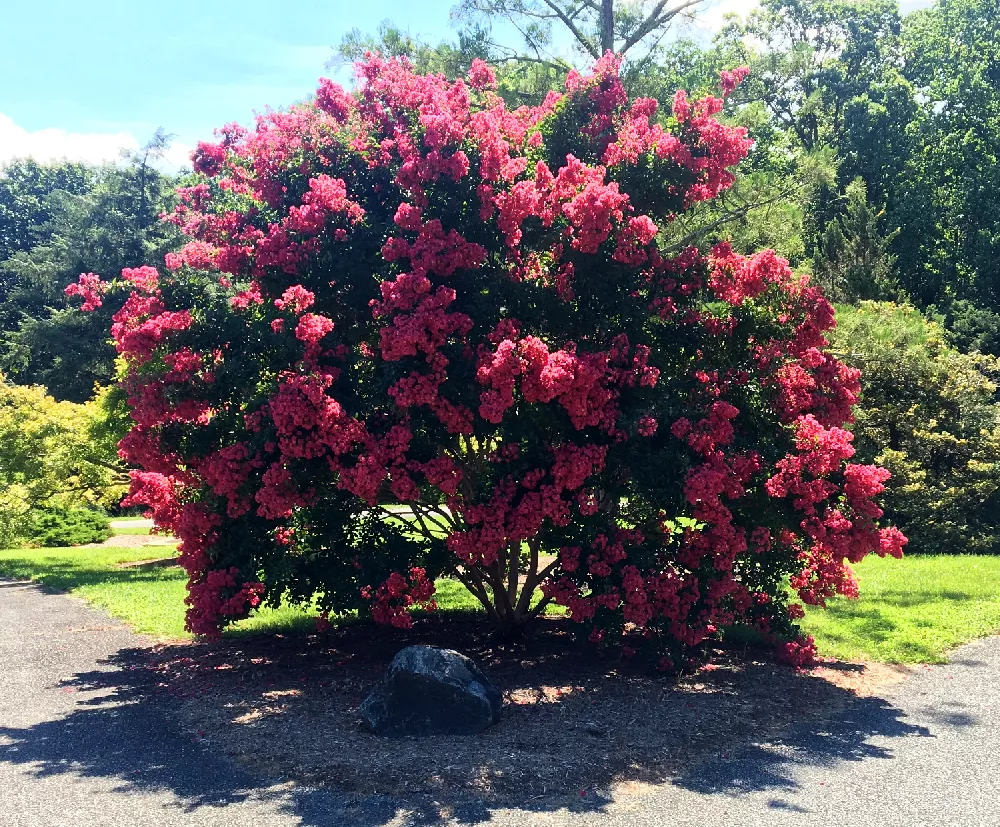- Home >
- Flowers >
- Trees and Plants with Pink Flowers >
- Pink Velour Crape Myrtle
Pink Velour Crape Myrtle for Sale - Buying & Growing Guide
- Ships in 1-2 days
- 1-Year Warranty Eligible
- Pots or accessories are not included unless specified in the product options.
Shipping Details:
Products shipped through FastGrowingTrees.com. Once your order is shipped, you’ll receive an email with a tracking number and estimated delivery date. Most orders will ship immediately.
It's just about impossible to miss the beauty that a pink velour crape myrtle offers your garden during the entire growing season. Not only does this myrtle variety have exceptional bright pink flowers, but it also boasts spectacular leaves that change colors during most of the year. That foliage first emerges in spring with a deep reddish color, which fades to dark green in summer, before finally turning orange in fall. All the while, the pink velour crape myrtle, or Lagerstroemia indica 'Whit III,' maintains a graceful multi-stemmed form.
- Showy pink flowers make for an intense color pop.
- The pink velour crape myrtle has a graceful multi-stemmed form.
- Its leaves change colors in spring, summer, and fall.
Plant Care
Sunlight

The pink velour crape myrtle grows best in full sun but may survive in a partial shade setting.
Watering
Observe soil moisture and provide water when the first 2 inches of soil are dry.
Fertilizing

Fertilize in spring with a mix that has equal amounts of nitrogen, phosphorus, and potassium.
Planting and Care
Planting instructions
The pink velour crape myrtle is an excellent ornamental plant option for anyone living in hardiness zones 7 through 10. If you live in that region, you can grow your pink velour crape myrtle in full sunlight or partial shade. However, while partial shade may keep this tree alive, full sunlight allows for the greatest health and better blooms. The soil in your tree’s growing location should be slightly acidic and nutrient-rich, and it should have good drainage to prevent waterlogging.
Watering and nutrients
After you plant your pink velour crape myrtle, you should water it once per week or more to ensure the soil remains moist while the tree establishes itself. Once your tree is somewhat mature, you can water it less often. The best way to know if your pink velour crape myrtle needs water is to check the soil moisture. If the first 2 or 3 inches of soil have become dry, it’s time to add water. Fertilize this plant in the early spring and a few more times during mid and late spring with a well-balanced fertilizer mix.
Pollination
The copious blooms that appear on your pink velour crape myrtle will invite many pollinator species to your garden, which makes pollination an easy task. Each of this plant’s flowers holds plenty of nectar, providing a reliable food source for pollinators, which, in turn, helps strengthen local ecosystems. Pink velour crape myrtles can reproduce via self-pollination or cross-pollination. However, since these plants don’t produce a harvest, pollination is not a main concern for those who raise them.
Pruning
Your first priority when pruning a pink velour crape myrtle should be to remove any branch that is dead, diseased, damaged, or crossing another branch. You will also have the opportunity to use your pruning cuts to improve the aesthetics of your tree. The most common way to do this with the pink velour crape myrtle is to remove the lower limbs to reveal the curving shapes that arise from this tree’s multi-stemmed form. Regardless of your pruning goal, you should conduct your pruning in late winter, just before the new growth appears.
Pests, diseases, and animals
Powdery mildew is a common problem for crape myrtles. However, the pink velour crape myrtle is often better able to ward off this common disease. Still, the pink velour crape myrtle can run into some pest and disease issues in its lifetime. Black spot, sooty mold, and tip blight are all possible complications that your tree may face. Likewise, pink velour crape myrtles can also experience infestations of aphids, ambrosia beetles, and Japanese beetles from time to time.
Achieving maximum results
One somewhat common problem with crape myrtles is over-fertilization. When a crape myrtle tree, including the pink velour crape myrtle, receives too much fertilizer, it may respond by producing more leaves and fewer flowers, which can drastically lower this plant’s ornamental value. This is especially the case if you use excessive applications of nitrogen-rich fertilizer. So, while fertilizer is generally beneficial to this plant, you should use some caution and be sure not to add too much each year.
FAQs
Is the pink velour crape myrtle a dwarf plant?
Is the pink velour crape myrtle a fast-growing plant?
Although the pink velour crape myrtle does not grow to an exceptionally large size, it also does not take long for it to reach that size. The pink velour crape myrtle typically adds about 2 feet of new growth each year when it grows where it can find favorable soil and light conditions. The better you are able to care for this plant, the more vigorously and quickly it is likely to grow.
How long is the bloom time of a pink velour crape myrtle?
The visual appearance of a pink velour crape myrtle's flowers is quite impressive, but what is equally impressive is how long these flowers remain on this plant each year. The blooms first open during the midsummer months and typically last until the fall. During that entire time, the pink velour crape myrtle will add tremendous color to your garden while attracting plenty of pollinators as well.
Compare Similar Products
You can't add more Product Name - Product size to the cart.
OK








